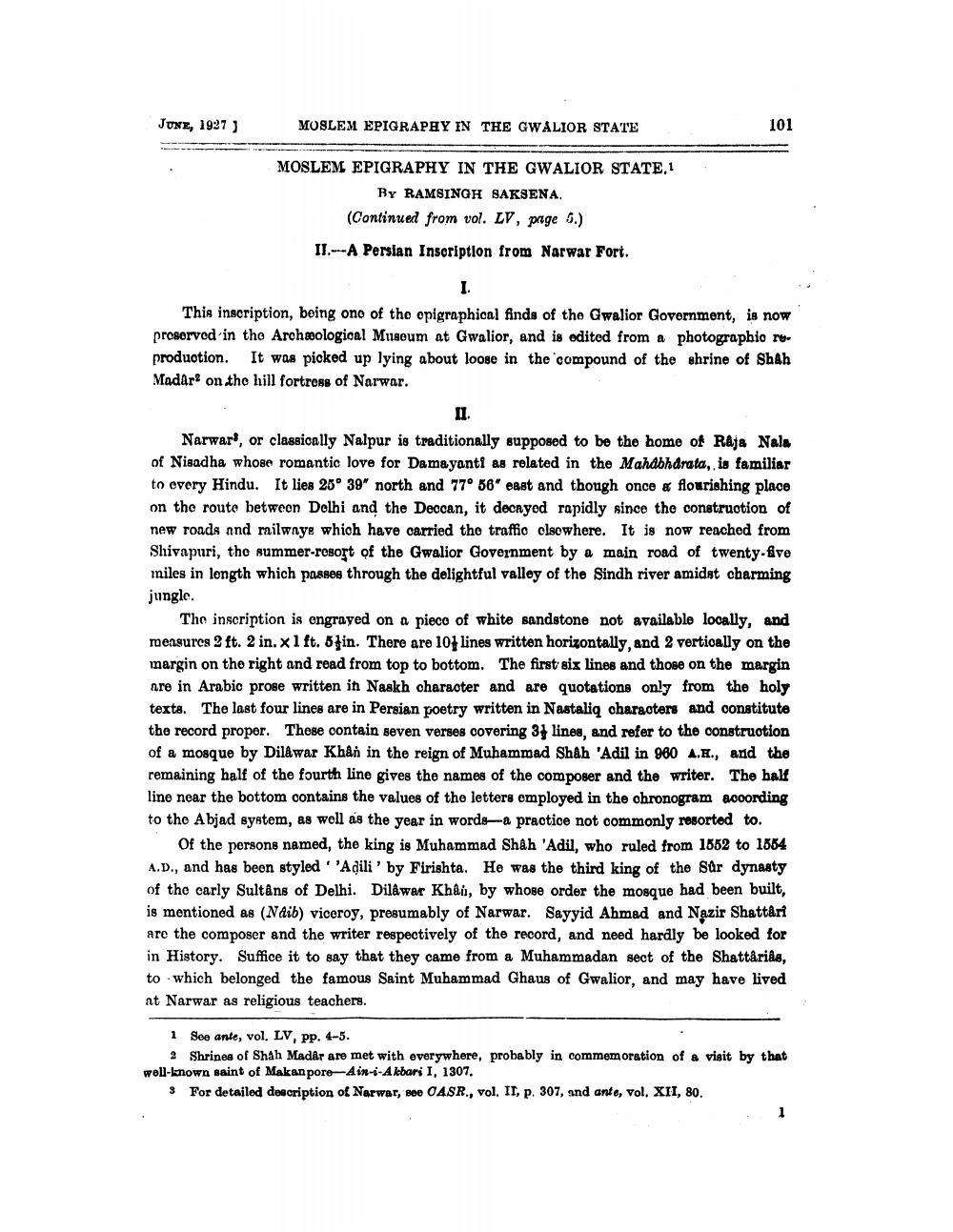________________
JUNE, 1927]
MOSLEM EPIGRAPHY IN THE GWALIOR STATE
MOSLEM EPIGRAPHY IN THE GWALIOR STATE.1 By RAMSINGH SAKSENA.
(Continued from vol. LV, page 5.)
II-A Persian Inscription from Narwar Fort.
101
I.
This inscription, being one of the epigraphical finds of the Gwalior Government, is now preserved in the Archaeological Museum at Gwalior, and is edited from a photographic reproduction. It was picked up lying about loose in the compound of the shrine of Shah Madar on the hill fortress of Narwar.
II.
Narwars, or classically Nalpur is traditionally supposed to be the home of Raja Nala of Nisadha whose romantic love for Damayanti as related in the Mahabharata, is familiar to every Hindu. It lies 25° 39" north and 77° 56" east and though once a flourishing place on the route between Delhi and the Deccan, it decayed rapidly since the construction of new roads and railways which have carried the traffic elsewhere. It is now reached from Shivapuri, the summer-resort of the Gwalior Government by a main road of twenty-five miles in length which passes through the delightful valley of the Sindh river amidst charming jungle.
The inscription is engraved on a piece of white sandstone not available locally, and measures 2 ft. 2 in. x 1 ft. 5in. There are 10 lines written horizontally, and 2 vertically on the margin on the right and read from top to bottom. The first six lines and those on the margin are in Arabic prose written in Naskh character and are quotations only from the holy texts. The last four lines are in Persian poetry written in Nastaliq characters and constitute the record proper. These contain seven verses covering 3 lines, and refer to the construction of a mosque by Dilawar Khân in the reign of Muhammad Shah 'Adil in 960 A.H., and the remaining half of the fourth line gives the names of the composer and the writer. The half line near the bottom contains the values of the letters employed in the chronogram according to the Abjad system, as well as the year in words-a practice not commonly resorted to.
Of the persons named, the king is Muhammad Shah 'Adil, who ruled from 1552 to 1554 A.D., and has been styled 'Adili' by Firishta. He was the third king of the Sûr dynasty of the early Sultans of Delhi. Dilawar Khân, by whose order the mosque had been built, is mentioned as (Naib) viceroy, presumably of Narwar. Sayyid Ahmad and Nazir Shattârî are the composer and the writer respectively of the record, and need hardly be looked for in History. Suffice it to say that they came from a Muhammadan sect of the Shattârias, to which belonged the famous Saint Muhammad Ghaus of Gwalior, and may have lived at Narwar as religious teachers.
"
1 See ante, vol. LV, pp. 4-5.
2 Shrines of Shah Madar are met with everywhere, probably in commemoration of a visit by that well-known saint of Makanpore-Ain-i-Akbari I, 1307.
3 For detailed description of Narwar, see CASR., vol. II, p. 307, and ante, vol, XII, 80.




